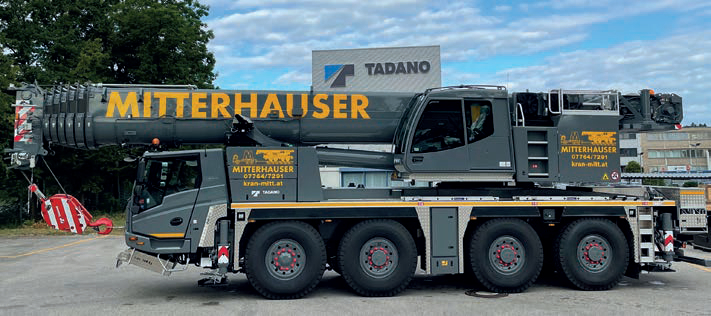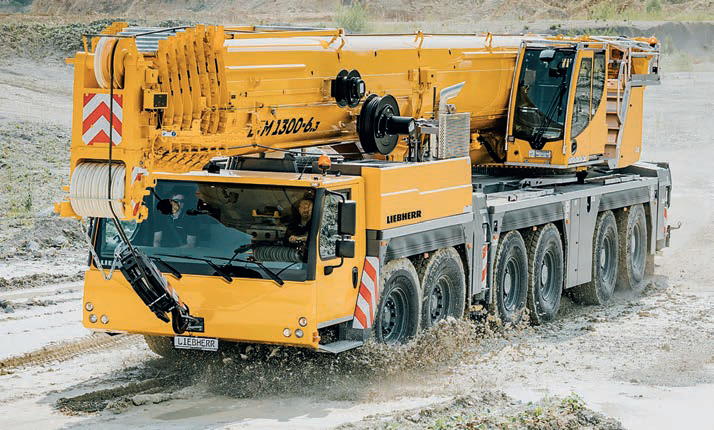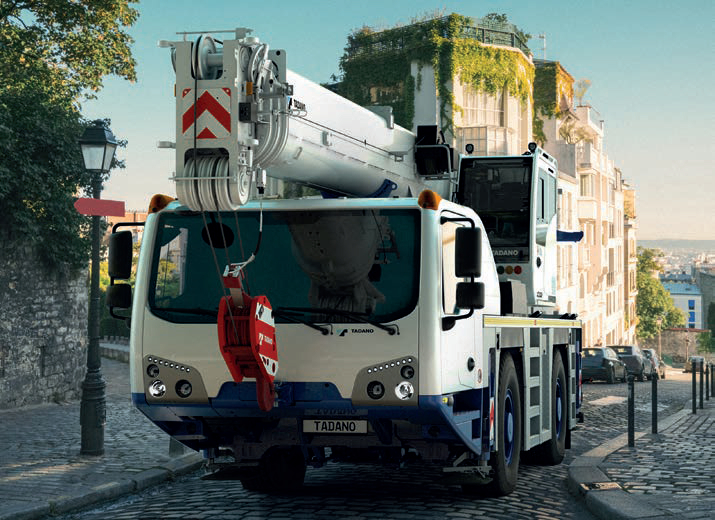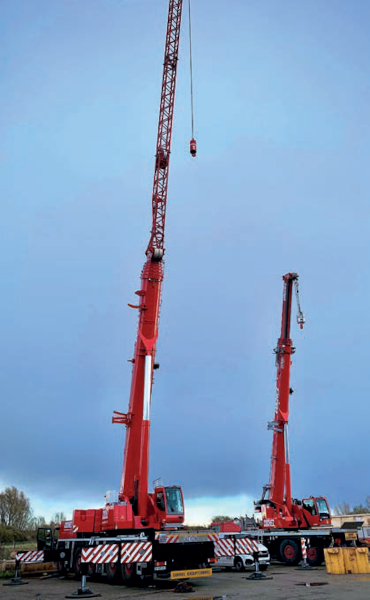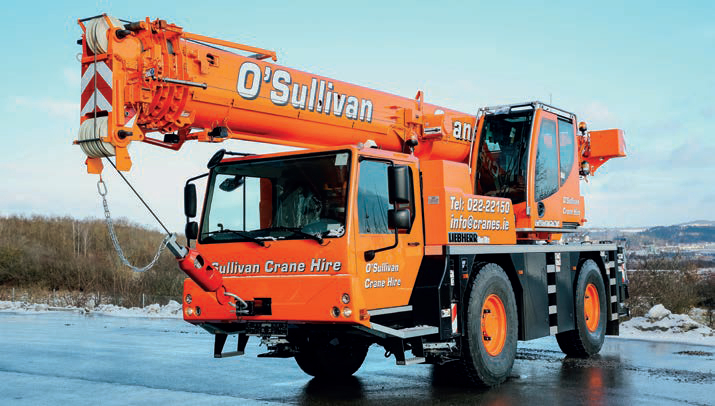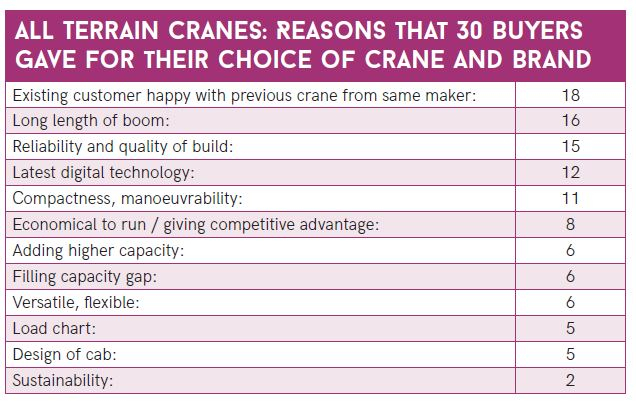All terrain buyers want what?!
1 September 2022What do all terrain crane users actually want? Is it higher capacity machines? Cranes with all-singing, all-dancing digital tech that calculates everything? Or do they just want basic assemblies of steel and wire rope than can lift as great a load as possible and do it on fewer axles than before? Julian Champkin investigates.
Manufacturers proclaim, with justified pride, their latest innovations. Thus Liebherr promote their very latest all terrain crane, the newly-introduced 300 tonne class LTM 1300-6.3, as the first all terrain able to travel on roads carrying a 90 metre telescopic boom with an axle load of just 12 tonnes. Which of those qualities are most greatly desired by its buyers though? Is it boom length, axle lead or capacity? What do customers actually want and find the most useful? To find out we have analysed comments from 30 end-users who have bought one or more all terrain cranes, from various manufacturers, over the past few months.
For our analysis we have considered several different categories – see table opposite – and counted the number of times each category was mentioned as a contributory factor in the decision to buy.
These comments are from genuine purchasers. They therefore reflect the criteria that those buyers considered as most important to them in making their choice.
Before we begin, though, a note of caution. Their statements are publicly available on manufacturers’ websites and the makers would not be likely to post unfavourable comments. That said, they do give a sense of the priorities that are uppermost in the minds of end-users. And those end-users have spent a lot of their own money in buying those cranes – so it is reasonable to suppose that they will have put a great deal of thought into their decisions. They really have put their money where their mouth is.
BRAND LOYALTY
One thing that very plainly emerges from the table is the strength of brand loyalty within the crane-buying sector. Of our 30 respondents, no fewer than 18 – well over half - said that this was not their first machine from that maker. Clearly a satisfactory or a good experience – of reliability, of aftersales care, of the relationship with the local dealer – counts for a lot in deciding a future purchase. Thus Horizon Reinforcing and Crane Hire, based in Falkirk, Scotland, has been ‘a Manitowoc customer for almost 30 years’ and bought the new GMK 5250XL-1 from Grove-Manitowoc ‘based on the quality of Grove cranes, the helpfulness of Manitowoc UK staff and the responsive service support provided’ over that time. So said director Stewart Dougall, whose late grandfather founded the company in 1973. It makes Horizon the first owner in Scotland to have that model.
Similarly, “We have been working with Grove for three years and our relationship with the whole team is very good,” said Abraham Molina, CEO of Grúas Alhambra in Spain. "We decided to purchase a new Grove GMK5250L-1 because of the very good results we got from our GMK5250L, and the excellent aftermarket support we received.”
Martin O’Sullivan, MD of O’Sullivan Crane Hire of Cork, Ireland, said the decision to replace his existing 40-tonne Liebherr with a Leibherr LTM 240-2.1 was based on “the performance of the older model and a strong relationship with the Liebherr team in Ireland.” Since his is a single-crane operation, making the right choice was clearly vital.
Austrian crane service provider Kran Mitterhauser has been using Tadano cranes for almost 30 years and has worked with every model released by the manufacturer in that time. Two-thirds of their fleet of 27 mobile cranes come from Tadano. “We have just had so many positive experiences with Tadano over the years,” says MD Helmut Mitterhauser.
The company has just bought an ATF-100-4.1. “We have already worked with the previous 90-tonne model in our fleet and our drivers never had any problems with it, so we know the 100-tonner will be no different.”
There are more economics-based reasons to stick with a brand as well: having all the cranes in your fleet from a single manufacturer greatly simplifies the logistics of maintenance, spares management, operator training and the rest. Thus French company Cochez, a subsidiary of Ponticelli and based at Valenciennes, has bought a Tadano AC 5.220-1. It not only meets the company’s needs perfectly but, as MD Xavier Charpentreau explains, “also comes with a vital advantage for us: its main boom extension can be shared with the crane’s identical sibling, which is stationed at our Ponticelli branch in Orléans. This makes both the crane’s acquisition and its use very cost-effective.”
And such synergies can be much bigger. German crane company Schuch has put in an order for no fewer than 15 new mobile cranes from Liebherr, ranging from 90t to 750t capacity. “A benefit for us, as a crane rental contractor, is the fact that the crane control systems are uniform on all Liebherr mobile cranes, from small to large,” says Tim Scuch, third-generation MD of the family-run company.
And Michael Ullrich, proprietor of Ullrich Krane of Chemnitz, has just bought the company’s 27th Liebherr crane.
BOOM LENGTH
In buying a house, property experts claim that three factors are paramount: first, location; second, location; and thirdly, location. Once a brand has been chosen buying a crane, it would seem, is similar.
First in importance is boom length. Second is boom length; and in third place comes, you guessed it, boom length. Our of our sample of 30 buyers, more than half – see table - gave the length of the boom – or, which is equivalent, the reach of the machine – as a prime or deciding factor.
Typical comments are: “The LTM1090-4.2 with its 60 metre main boom and the ballast which it can carry within its 48 tonne gross weight is now the perfect machine for this lifting capacity class”– from Johann Saller, MD of Kranverleih Saller of Winhöring in Bavaria; and, “The 66 metre telescopic boom [of the new LTM 1150- 5.3] was an important criterion behind the decision” – Goran Karanovic, founder and owner of Beokran, based in the Serbian capital Belgrade. The telescopic boom on the LTM 1150-5.3 is six metres longer than the one on its predecessor, the LTM 1130-5.1.
Of the same crane Werner Glück, owner and managing director of Alfred Klug, based in Hof, Germany, says: "The 66-metre boom of the LTM 1150- 5.3 was an important decision criterion for us.”
“It’s got the best-in-class boom length and is efficient to set up,” said Stewart Dougall of Horizon (whom we heard from above regarding his Grove GMK5250XL1). And, Leon Huang, sales manager at Taiwan dealership Champion Auto, who has just sold a Grove GMK5250XL-1 to a local purchaser, commented: “Customers need power and reach to help with the large number of high-rise projects in this country.”
RELIABILITY/QUALITY
Exactly half of our sample mentioned reliability or quality of build in their reasoning. Possibly it is implicit in those who those who approvingly quoted brand familiarity above. Jens Sundqvist, co-proprietor of Swedish crane service provider Hellbergs Entreprenad, bought a second-hand Tadano ATF130G-5, as an urgently-needed assist crane on a windfarm project and, despite its being a used machine, had no qualms: he was familiar, he said, with the crane’s high quality and accordingly has zero worries about the reliability of the unit.
It works for new cranes also: “[The Tadano 100G-4] is almost unbelievably reliable”; that is Thomas Hienrichs of Heinrichs & Co KG, East Westphalia. “The quality of Grove cranes is superb, and we’ve had such a great experience with the brand. When our operator pulled into the yard after his first job with the GMK3060L-1, he had the biggest smile on his face.” That rather heartwarming testamonial is from Andrew Smith, director of KAS Cranes Hire in Devon.
“We already have a LTM 1130-5.1 mobile crane from Liebherr, which provides us with reliable service” says André Tadeu, Operational Manager of Calsimec group in Brazil, which has just bought its first LTM 1250-5.1.
Another South American purchaser, Mexican crane contractor Levantek, is new to Leibherr but a visit to the company’s factory in Germany helped – as did Germany’s manufacturing reputation in general: “Our investment in a five-axle mobile crane was an important strategic decision for us,” said company owner Ferdinando Paez Trevino. “We also considered purchasing a used crane. Ultimately we decided on a new LTM1160-5.2. I was very impressed with the quality in the production at Liebherr. I have had good experience with ‘Made in Germany’ products as many of my fleet of around 200 trucks come from Germany. That also made the decision an easy one.”
TECHNOLOGY
The highest and latest in digital technology comes, perhaps surprisingly, only fourth in our list, getting 12 mentions in all. Adam Gausel from Nelson on the South Island of New Zealand has been in the industry for over 20 years and has just struck out on his own. He chose the Grove GMK3060L-1 to start his new mobile crane hire company Adam’s Crane. “The main innovation setting it apart is the radio control function and I am challenging some traditional thinking by operating the crane from the ground rather than in the cab for the bulk of the work I do,” he said.
“The concepts of VarioBallast and VarioBase are another benefit of the [Liebherr] crane,” said Birgit Steil, owner of Steil Kranarbeite, based in Trier.
Technology goes hand in hand with fuel economy - and therefore competitiveness – and with sustainability. “The Liebherr cranes that we invest in are always state of the art and enable us to minimise our fuel consumption and reduce noise emissions”, says Eric Lelieur, owner of Lelieur Levage which serves northern France. “That means that they help to make work on sites as green as possible. We choose Liebherr because the brand enables us to demonstrate our commitment for limiting our CO2 footprint.”
Another comment in the same vein is from Michael Ullrich, of Ullrich Krane of Chemnitz, whom we mentioned earlier as a Liebherr multi-owner: “The latest Liebherr engine and drivechain technology enables us to modify our crane fleet to make it greener. Reducing fuel consumption and CO2 emissions is one of our main challenges.”
Sadly, despite the huge efforts that manufactures are putting in to creating the greener cranes of the future – Zoomlion’s hybrid-powered all terrain (see box on page 26) is just an example – Lelieur and Ullrich were the only company spokesmen who explicitly mentioned sustainability as part of the reason for their choice. Many, however, mentioned fuel-efficiency and economical running as important. The moral would seem to be that in order widely to penetrate the market cranes must be not only greener than their conventional competitors but also cheaper to run.
A slight two-edged compensation is that the current huge rises in the price of diesel have at least made this a somewhat easier target to achieve. If it is not making greener cranes cheaper to run it is certainly making diesel ones more expensive.
Other comments in the technology-competitiveness vein are from site manager Nils Laumann of I & H Kran – Transport – Montage of Saxony, for whom the two-engine concept of the Tadano AC 100-4L was a factor. However, “the absolute technical highlight is the IC-1 Plus control system. Lifting capacities are significantly increased at various slewing angles in many cases, even with a partial counterweight, and that makes using this crane particularly cost-effective in many projects.”
Three related categories come next. 'Higher capacity' and 'filling a capacity gap in our fleet' and 'load charts' are related categories; the first two received six mentions apiece, while 'load charts' received five. It undeniable that load weights are increasing. So is the demand for cranes that can lift them. “The requirements in industry and wind power are constantly on the rise, as are the required lifting capacities,” said Birgit Steil whom we quoted above. But manoeuvrability (including compact size) is also important. Usually capacity and manoeuvrability pull in opposite directions and the makers must decide on the balance that is right for them. Sometimes they get it right: “The crane combines compact size and high lift performance,” says Hugh Simpson, whose Hugh Simpson (Contractors) is based in Wick in the very north of Scotland. He is speaking of his new LTM1650-8.1. “With eight axles this crane can complete hoisting work in the 700-tonne class or even higher with ease.”
But, as that quote made clear, as important as high capacity is the flexibility and compact size that lets the crane actually get to the jobsite. Eleven respondents spoke of ‘compactness’ as one of the virtues. “As well as power and reach customers also need a crane that is easy and economical to move because of the busy urban centres spread across a large country,” continues Leon Huang of Taiwan.
“The GMK5250XL-1 has practically the same boom length (78.5 m) as the GMK6300L (80 m) but on five-axles, so it just made sense,” said Stewart Dougall of Horizon.
Johann Saller again: “We have just bought the fourth generation of the same crane in 40 years. Thanks to technical progress, the same lifting capacity is now possible with two fewer axles than on the original LT truck crane –despite the fact that the modern crane [the LTM 1090-4.2] has a significantly longer telescopic boom.”
And, speaking of his new Tadano AC 7.450-1, to be tasked with erecting tower cranes, Dominik Magg of Weiss Kranservice in Swabia said: “Definitely its compact design in combination with the large lifting capacity and long boom [swung the decision to buy it.] To put it simply, work sites keep getting tighter and tighter, while tower cranes keep getting bigger and bigger.”
We have not yet mentioned cab design, which received five mentions, as important from our buyers... a comfortable crane operator is, after all, a happy crane operator. But there you more or less have it. Those are the priorities that buyers consider when looking for new cranes.
The bottom line for crane manufacturers seems clear: if they can make an all terrain crane with a longer boom length than before, a higher capacity than before, a shorter chassis and carried on fewer axles than before; at the same time give it unrivalled reliability and versatility, make it economical as well as eco-friendly to operate, and provide with it the very best of after-sales service and follow-up as well… well, if they could do all of that they would probably have a winner on their hands.
In the real world it is of course an impossible list of contradictory demands. What is surprising is that so many modern manufacturers have got so close to it.
